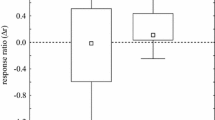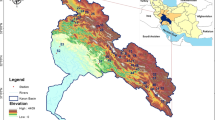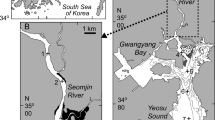Abstract
Isotopic niches reflect the basic structure and functioning of river food webs; however, their response to riverine environments remains unclear. We used stable isotope analysis and community-wide metrics to quantify how invertebrate niches vary with environmental changes along a large subtropical river in China. Eight niche metrics, which had higher values in the wet than in the dry season, increased from headwaters to the middle river and decreased sharply near the estuarine industrial zones. The δ13C value of > − 23.8‰, which indicated consumption of epilithic diatoms, separated the invertebrates between the upper and mid-lower reaches. The δ15N values > 9.4‰ identified site-specific nitrogen sources from manure (e.g., animal effluent) and domestic sewage in agricultural area. The output of mixing models showed a downstream shift in carbon utilization by invertebrates from autochthonous periphyton and submerged hydrophytes to allochthonous C3 plants. Principle component (PC) and cluster analysis decomposed and grouped 40 environmental variables into 4 PCs that explained 84.5% of the total variance. Hierarchical partitioning revealed that the second and first PCs, which were driven mainly by biological indicators and habitat characteristics, had the highest explanatory power for niche ranges and areas (e.g., Bayesian ellipse), respectively. Our results suggest that reducing anthropogenic pressures (e.g., habitat loss and water pollution) on river ecosystems through measures, such as protecting diatom-dominated biofilms in riffles and controlling nitrogen loading in rural regions, may produce the greatest impact for river management.

Graphical abstract







Similar content being viewed by others
Data availability
The authors confirm that the data supporting the findings of this study are available within the article and its supplementary materials.
References
Abrantes KG, Barnett A, Bouillon S (2014) Stable isotope-based community metrics as a tool to identify patterns in food web structure in east African estuaries. Funct Ecol 28:270–282
Anderson C, Cabana G (2005) δ15N in riverine food webs: effects of N inputs from agricultural watersheds. Can J Fish Aquat Sci 62:333–340
Anderson C, Cabana G (2006) Does δ15N in river food webs reflect the intensity and origin of N loads from the watershed? Sci Total Environ 367:968–978
Bearhop S, Adams CE, Waldron S, Fuller RA, Macleod H (2004) Determining trophic niche width: a novel approach using stable isotope analysis. J Anim Ecol 73:1007–1012
Bergfur J, Johnson RK, Sandin L, Goedkoop W (2009) Effects of nutrient enrichment on C and N stable isotope ratios of invertebrates, fish and their food resources in boreal streams. Hydrobiologia 628:67–79
Carabel S, Godínez-Domínguez E, Verísimo P, Fernández L, Freire J (2006) An assessment of sample processing methods for stable isotope analyses of marine food webs. J Exp Mar Biol Ecol 336:254–261
Chang CC, Kendall C, Silva SR, Battaglin WA, Campbell DH (2002) Nitrate stable isotopes: tools for determining nitrate sources among different land uses in the Mississippi River Basin. Can J Fish Aquat Sci 59:1874–1885
Clapcott JE, Young RG, Goodwin EO, Leathwick JR (2010) Exploring the response of functional indicators of stream health to land-use gradients. Freshw Biol 55:2181–2199
Cucherousset J, Villéger S (2015) Quantifying the multiple facets of isotopic diversity: new metrics for stable isotope ecology. Ecol Indic 56:152–160
Davis AM, Blanchette ML, Pusey BJ, Jardine TD, Pearson RG (2012) Gut content and stable isotope analyses provide complementary understanding of ontogenetic dietary shifts and trophic relationships among fishes in a tropical river. Freshw Biol 57:2156–2172
di Lascio A, Rossi L, Carlino P, Calizza E, Rossi D, Costantini ML (2013) Stable isotope variation in macroinvertebrates indicates anthropogenic disturbance along an urban stretch of the river Tiber (Rome, Italy). Ecol Indic 28:107–114
Diebel MW, Zanden MJV (2009) Nitrogen stable isotopes in streams: effects of agricultural sources and transformations. Ecol Appl 19:1127–1134
Doi H (2009) Spatial patterns of autochthonous and allochthonous resources in aquatic food webs. Popul Ecol 51:57–64
Finlay JC (2001) Stable-carbon-isotope ratios of river biota: implications for energy flow in lotic food webs. Ecology 82:1052–1064
Fisher SJ, Brown ML, Willis DW (2001) Temporal food web variability in an upper Missouri River backwater: energy origination points and transfer mechanisms. Ecol Freshw Fish 10:154–167
Fraser LH, Harrower WL, Garris HW, Davidson S, Hebert PD, Howie R, Moody A, Polster D, Schmitz OJ, Sinclair AR (2015) A call for applying trophic structure in ecological restoration. Restor Ecol 23:503–507
Hamilton SK, Sippel SJ, Bunn SE (2005) Separation of algae from detritus for stable isotope or ecological stoichiometry studies using density fractionation in colloidal silica. Limnol Oceanogr Methods 3:149–157
Hoeinghaus DJ, Winemiller KO, Agostinho AA (2007) Landscape-scale hydrologic characteristics differentiate patterns of carbon flow in large-river food webs. Ecosystems 10:1019–1033
Hutchinson GE (1957) Concluding remarks: Cold Spring Harbor Symposia on Quantitative Biology. Cold Spring Harb Symp Quant Biol 22:415–457
Jabot F, Giraldo C, Lefebvre S, Dubois S (2017) Are food web structures well represented in isotopic spaces? Funct Ecol 31:1975–1984
Jackson AL, Inger R, Parnell AC, Bearhop S (2011) Comparing isotopic niche widths among and within communities: SIBER – stable isotope Bayesian ellipses in R. J Anim Ecol 80:595–602
Kobayashi S, Akamatsu F, Amano K, Nakanishi S, Oshima Y (2011) Longitudinal changes in δ13C of riffle macroinvertebrates from mountain to lowland sections of a gravel-bed river. Freshw Biol 56:1434–1446
Lau DCP, Leung KMY, Dudgeon D (2009) What does stable isotope analysis reveal about trophic relationships and the relative importance of allochthonous and autochthonous resources in tropical streams? A synthetic study from Hong Kong. Freshw Biol 54:127–141
Layman CA, Arrington DA, Montaña CG, Post DM (2007a) Can stable isotope ratios provide for community-wide measures of trophic structure? Ecology 88:42–48
Layman CA, Quattrochi JP, Peyer CM, Allgeier JE (2007b) Niche width collapse in a resilient top predator following ecosystem fragmentation. Ecol Lett 10:937–944
Lee JHW, Wang ZY, Thoe W, Cheng DS (2007) Integrated physical and ecological management of the East River. Water Sci Technol Water Supply 7:81–91
Lefebvre S, Clément J-C, Pinay G, Thenail C, Durand P, Marmonier P (2007) 15N-Nitrate signature in low-order streams: effects of land cover and agricultural practices. Ecol Appl 17:2333–2346
Legendre P, Legendre LF (2012) Numerical ecology, Third edn. Elsevier, New York
Maceda-Veiga A, Mac Nally R, De Sostoa A (2018) Environmental correlates of food-chain length, mean trophic level and trophic level variance in invaded riverine fish assemblages. Sci Total Environ 644:420–429
Morse JC, Yang L, Tian L (1994) Aquatic insects of China useful for monitoring water quality. Hohai University Press, Nanjing
Newsome SD, Martinez Del Rio C, Bearhop S, Phillips DL (2007) A niche for isotopic ecology. Front Ecol Environ 5:429–436
Piggott JJ, Townsend CR, Matthaei CD (2015) Reconceptualizing synergism and antagonism among multiple stressors. Ecol Evol 5:1538–1547
Pingram MA, Collier KJ, Hamilton DP, David BO, Hicks BJ (2012) Carbon sources supporting large river food webs: a review of ecological theories and evidence from stable isotopes. Freshw Rev 5:85–104
Post DM, Pace ML, Hairston NG Jr (2000) Ecosystem size determines food-chain length in lakes. Nature 405:1047–1049
Post DM, Layman CA, Arrington DA, Takimoto G, Quattrochi J, Montaña CG (2007) Getting to the fat of the matter: models, methods and assumptions for dealing with lipids in stable isotope analyses. Oecologia 152:179–189
Power ME, Dietrich WE (2002) Food webs in river networks. Ecol Res 17:451–471
R Core Team (2013) R: A language and environment for statistical computing
Reid AJ, Carlson AK, Creed IF, Eliason EJ, Gell PA, Johnson PTJ, Kidd KA, Maccormack TJ, Olden JD, Ormerod SJ, Smol JP, Taylor WW, Tockner K, Vermaire JC, Dudgeon D, Cooke SJ (2019) Emerging threats and persistent conservation challenges for freshwater biodiversity. Biol Rev 94:849–873
Roach KA (2013) Environmental factors affecting incorporation of terrestrial material into large river food webs. Freshw Sci 32:283–298
Stock BC, Jackson AL, Ward EJ, Parnell AC, Phillips DL, Semmens BX (2018) Analyzing mixing systems using a new generation of Bayesian tracer mixing models. PeerJ 6:e5096
Vander Zanden MJ, Olden JD, Gratton C, Tunney TD (2016) Food web theory and ecological restoration. In: Palmer MA, Zedler JB, Falk DA (eds) Foundations of restoration ecology. Springer, pp 301–329
Wallace JB, Webster JR (1996) The role of macroinvertebrates in stream ecosystem function. Annu Rev Entomol 41:115–139
Wang ZY, Lee JHW, Cheng DS, Duan XH (2008) Benthic invertebrates investigation in the East River and habitat restoration strategies. J Hydro Environ Res 2:19–27
Wang S, Wang L, Chang H-Y, Li F, Tang J-P, Zhou X-A, Li X, Tian S-M, Lin H-J, Yang Y (2018) Longitudinal variation in energy flow networks along a large subtropical river, China. Ecol Model 387:83–95
Wang S, Wang L, Zheng Y, Chen Z-B, Yang Y, Lin H-J, Yang X-Q, Wang T-T (2019a) Application of mass-balance modelling to assess the effects of ecological restoration on energy flows in a subtropical reservoir, China. Sci Total Environ 664:780–792
Wang S, Tang J-P, Su L-H, Fan J-J, Chang H-Y, Wang T-T, Wang L, Lin H-J, Yang Y (2019b) Fish feeding groups, food selectivity, and diet shifts associated with environmental factors and prey availability along a large subtropical river, China. Aquat Sci 81:31
Wayland M, Hobson KA (2001) Stable carbon, nitrogen, and sulfur isotope ratios in riparian food webs on rivers receiving sewage and pulp-mill effluents. Can J Zool 79:5–15
Zeug SC, Winemiller KO (2008) Evidence supporting the importance of terrestrial carbon in a large-river food web. Ecology 89:1733–1743
Zhang Y, Shi P, Song J, Li Q (2019) Application of nitrogen and oxygen isotopes for source and fate identification of nitrate pollution in surface water: a review. Appl Sci 9:18
Acknowledgments
This research was financially supported by the National Natural Science Foundation of China (51909107 and U1501235), China Postdoctoral Science Foundation (2019 M653284), the Science and Technology Program of Guangzhou (201704020158), China Innovation & Entrepreneurship Competition for Undergraduate (S201910559065 and CX2019040), National Science and Technology Major Project for Water Pollution Control and Treatment (2012ZX07206-006), and the Knowledge Innovation Program of Shenzhen (JCYJ20160526162154729).
Author information
Authors and Affiliations
Contributions
SW and LHS conceived the ideas and designed the methodology. SW, LHS, BKL, and YJQ performed field and laboratory work. SW, GC, SDS, JPT, and TTW collected and analyzed the data. SW, SDS, YY, and GC led the writing of the manuscript. All authors contributed critically to the drafts and gave final approval for publication.
Corresponding authors
Ethics declarations
Conflicts of interest
The authors declare that they have no competing interests.
Additional information
Responsible Editor: Philippe Garrigues
Publisher’s note
Springer Nature remains neutral with regard to jurisdictional claims in published maps and institutional affiliations.
Electronic supplementary material
ESM 1
(DOCX 23.0 MB)
Rights and permissions
About this article
Cite this article
Wang, S., Su, LH., Luo, BK. et al. Stable isotopes reveal effects of natural drivers and anthropogenic pressures on isotopic niches of invertebrate communities in a large subtropical river of China. Environ Sci Pollut Res 27, 36132–36146 (2020). https://doi.org/10.1007/s11356-020-09252-8
Received:
Accepted:
Published:
Issue Date:
DOI: https://doi.org/10.1007/s11356-020-09252-8




